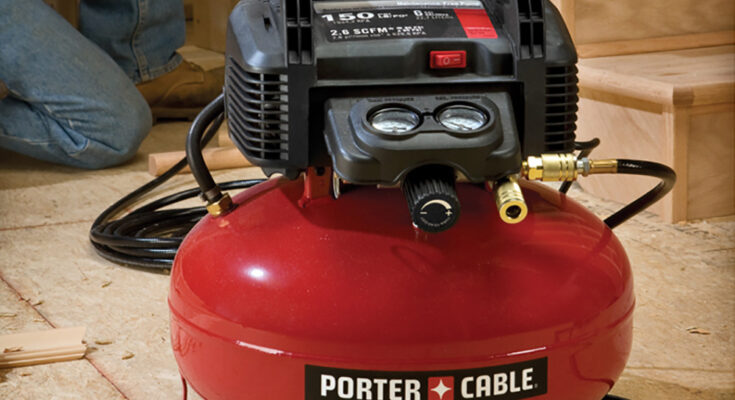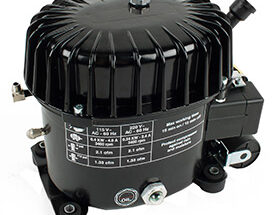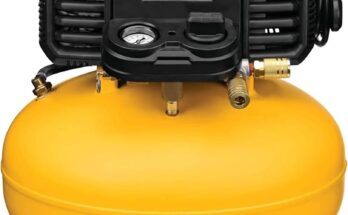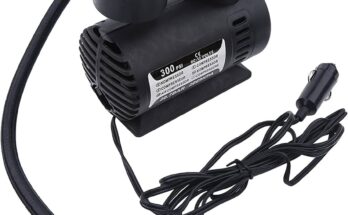Many people think using an air compressor is complicated and only for professionals. But guess what? It’s not! With a little guidance, anyone can master this handy tool. Whether you’re a DIY enthusiast or just someone who loves to tackle home improvement projects, learning how to use an air compressor can save you time, effort, and money.
In this blog, we’ll walk you through everything you need to know about how to use an air compressor. From the basics of what it is to the different types available, by the end of this read, you’ll feel confident and ready to get started with your air compressor and how to use an air compressor.
What is an Air Compressor?
So, what exactly is and how to use an air compressor? In simple terms, an air compressor is a device that converts power (using an electric motor, diesel, or gasoline engine) into potential energy stored in pressurized air. Think of it as a fancy pump that pushes air into a tank, building up pressure that you can then use to power various tools and applications.
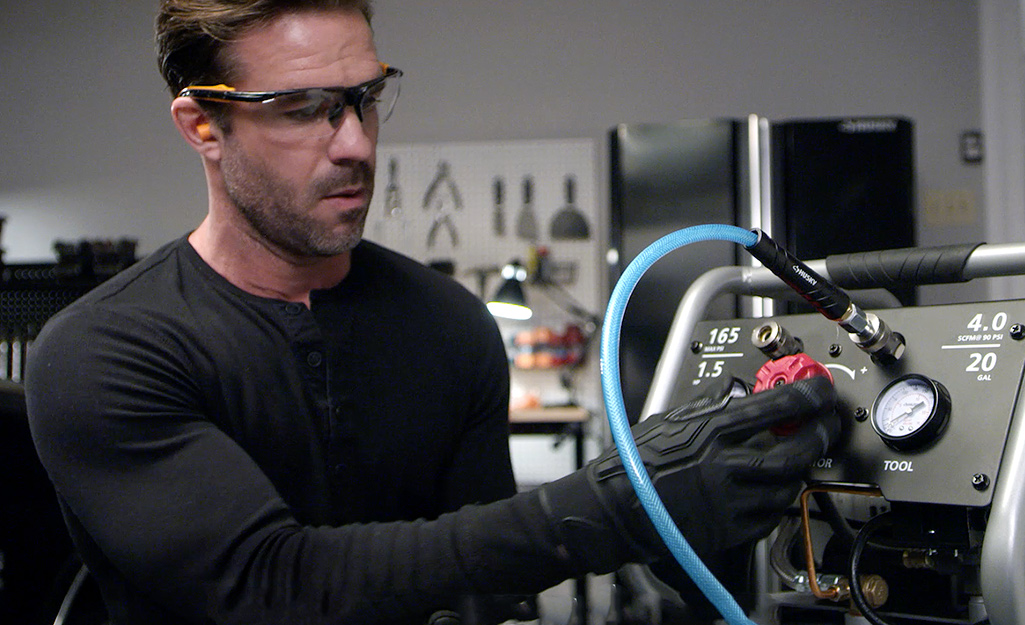
Photo By: homedepot.com
Basic Components of an Air Compressor
Understanding the basic components of how to use an air compressor help you get a better grasp of how it works. Here’s a quick rundown:
- Motor: This is the powerhouse of the compressor. It drives the pump that compresses the air.
- Pump: The pump is what actually compresses the air, pushing it into the tank.
- Tank: The tank stores the compressed air until you’re ready to use it.
- Pressure Gauge: This shows you the pressure level inside the tank.
- Regulator: This allows you to adjust the pressure coming out of the tank to match the needs of your tool.
- Hose: The hose connects the compressor to your tools.
- Safety Valve: This is a crucial component that prevents the pressure from getting too high and causing a safety hazard.
How To Use An Air Compressor?
The process is pretty straightforward. When you turn on the compressor, the motor starts up and drives the pump. The pump then sucks in air from the outside, compresses it, and stores it in the tank. As the tank fills up, the pressure inside increases. When you connect a tool and open the valve, the compressed air rushes out, providing the power needed to operate the tool.
Types of Air Compressors
You might think how to use an air compressor , but that’s not true. Different types of air compressors are designed for different tasks. Understanding these differences can help you choose the right one for your needs.
Portable vs. Stationary Air Compressors
Portable Air Compressors
- Portability: As the name suggests, these are easy to move around. They are usually smaller and lighter, making them perfect for jobs that require mobility.
- Use Cases: Ideal for tasks like inflating tires, powering nail guns, or using with other light to medium-duty tools.
Stationary Air Compressors
- Stationary Setup: These are larger and meant to be fixed in one location. They often have larger tanks and more powerful motors.
- Use Cases: Best for heavy-duty tasks like running multiple air tools in a workshop or industrial setting.
Single-Stage vs. Two-Stage Air Compressors
Single-Stage Compressors
- Operation: In a single-stage compressor, air is compressed once and then stored in the tank.
- Use Cases: Suitable for smaller jobs and lower-pressure applications. Good for DIY enthusiasts and light-duty tasks.
Two-Stage Compressors
- Operation: Air is compressed twice, which results in higher pressure. This makes them more efficient for larger jobs.
- Use Cases: Ideal for commercial use or for powering tools that require higher pressure.
Oil-Free vs. Oil-Lubricated Air Compressors
Oil-Free Compressors
- Maintenance: These require less maintenance because they don’t need oil changes. They’re also cleaner since there’s no risk of oil spills.
- Use Cases: Perfect for tasks that need clean air, like painting or food-grade applications.
Oil-Lubricated Compressors
- Durability: These tend to last longer and run quieter because the oil lubricates the moving parts.
- Use Cases: Better for heavy-duty use and industrial applications where durability is key.
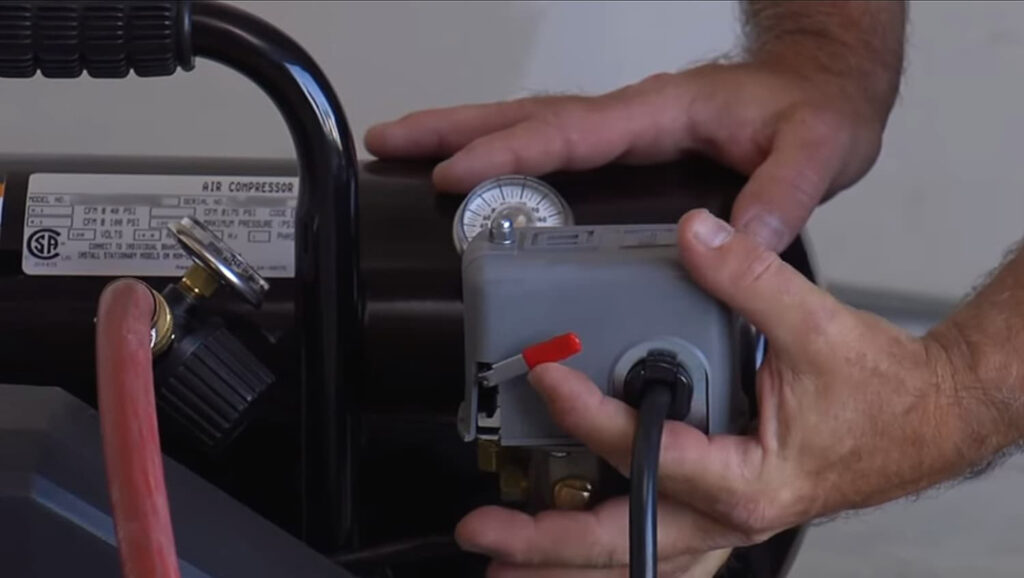
Photo By: mitm.com
How to Set Up an Air Compressor
Setting up an air compressor might seem daunting, but it’s easier than you think. Here’s a simple step-by-step guide to get you started.
Checking the Components
Before you do anything, make sure all the parts are there. Check the manual to confirm you have all components, including the compressor, hose, connectors, and any tools you might need.
Assembling Parts
- Attach the Hose: Connect one end of the hose to the air compressor and the other end to your tool. Make sure the connections are tight to avoid leaks.
- Install the Regulator: If your compressor has a regulator, attach it to control the air pressure going to your tools.
Connecting the Hose
- Secure Connections: Ensure all connections are secure. Loose connections can lead to air leaks and inefficiency.
- Check for Leaks: After connecting everything, turn on the compressor briefly to check for any air leaks. If you hear hissing, re-tighten the connections.
Powering Up
- Plug In: Connect your air compressor to a power source. Make sure you use a heavy-duty extension cord if needed.
- Turn On: Switch on the compressor. Let it run until it reaches the desired pressure, which you can monitor using the pressure gauge.
Adjusting Pressure Settings
- Set the Regulator: Adjust the regulator to set the desired pressure for your tool. Different tools require different pressures, so check the tool’s manual for the correct settings.
- Test the Tool: Attach your tool and give it a test run to make sure it’s working properly.
Setting up your air compressor correctly ensures it runs efficiently and safely. With these steps, you’ll be ready to tackle your projects with confidence.
FAQs How To Use An Air Compressor
1. What size air compressor do I need for home use?
For most home use, a portable air compressor with a tank size of 2-6 gallons should be sufficient. These are great for tasks like inflating tires, powering nail guns, and other light to medium-duty tools. If you plan to use it for more demanding applications, consider a larger stationary model.
2. How To Use An Air Compressor for painting?
Yes, you can use an air compressor for painting, but make sure it’s an oil-free model to avoid any contamination in your paint. You’ll also need a compressor with enough CFM (cubic feet per minute) to handle your paint sprayer. Check your sprayer’s requirements to ensure compatibility.
3. How often should I maintain my air compressor?
Maintenance frequency depends on how often you use your compressor. Generally, you should check the oil levels (if it’s an oil-lubricated model) before each use, drain the tank after each use to prevent moisture buildup, and replace air filters regularly. Refer to the manufacturer’s manual for a specific maintenance schedule.
4. Why is my air compressor making a loud noise?
Loud noises from your air compressor can be due to several reasons, including loose parts, a faulty motor, or inadequate lubrication. Check for loose screws and bolts, ensure the motor is functioning correctly, and make sure oil-lubricated models have enough oil. If the noise persists, consult a professional.
5. Can I use an extension cord with my air compressor?
Yes, you can use an extension cord with your air compressor, but make sure it’s a heavy-duty cord capable of handling the power load of the compressor. Using a regular extension cord can lead to overheating and potential fire hazards.
6. How do I adjust the pressure settings on my air compressor?
Adjusting the pressure settings is straightforward. Locate the regulator knob on your compressor and turn it to increase or decrease the pressure. Make sure to check your tool’s manual for the recommended pressure settings to ensure safe and efficient operation.
7. What should I do if my air compressor is leaking air?
If your air compressor is leaking air, first check all the connections to ensure they are tight. Inspect the hoses and fittings for any signs of wear or damage. If everything looks fine and the leak persists, you might have a faulty valve or gasket, which may require professional repair.
8. How long can I run my air compressor continuously?
The continuous runtime of an air compressor depends on the model and its specifications. Generally, oil-lubricated compressors can run for longer periods than oil-free models. Always check the manufacturer’s guidelines and avoid running the compressor continuously for longer than recommended to prevent overheating and damage.
9. Do I need a special storage space for my air compressor?
While you don’t need a special storage space, it’s best to store your air compressor in a clean, dry, and well-ventilated area. Keep it away from direct sunlight and extreme temperatures to prolong its lifespan. If it’s a portable model, ensure it’s stored in a place where it won’t be knocked over or damaged.
10. Can I use my air compressor in cold weather?
Using an air compressor in cold weather can be challenging, as the oil can thicken and make it harder for the compressor to start. If you must use it in cold conditions, keep it in a warm place until you need it, or use a cold-weather oil designed for a
